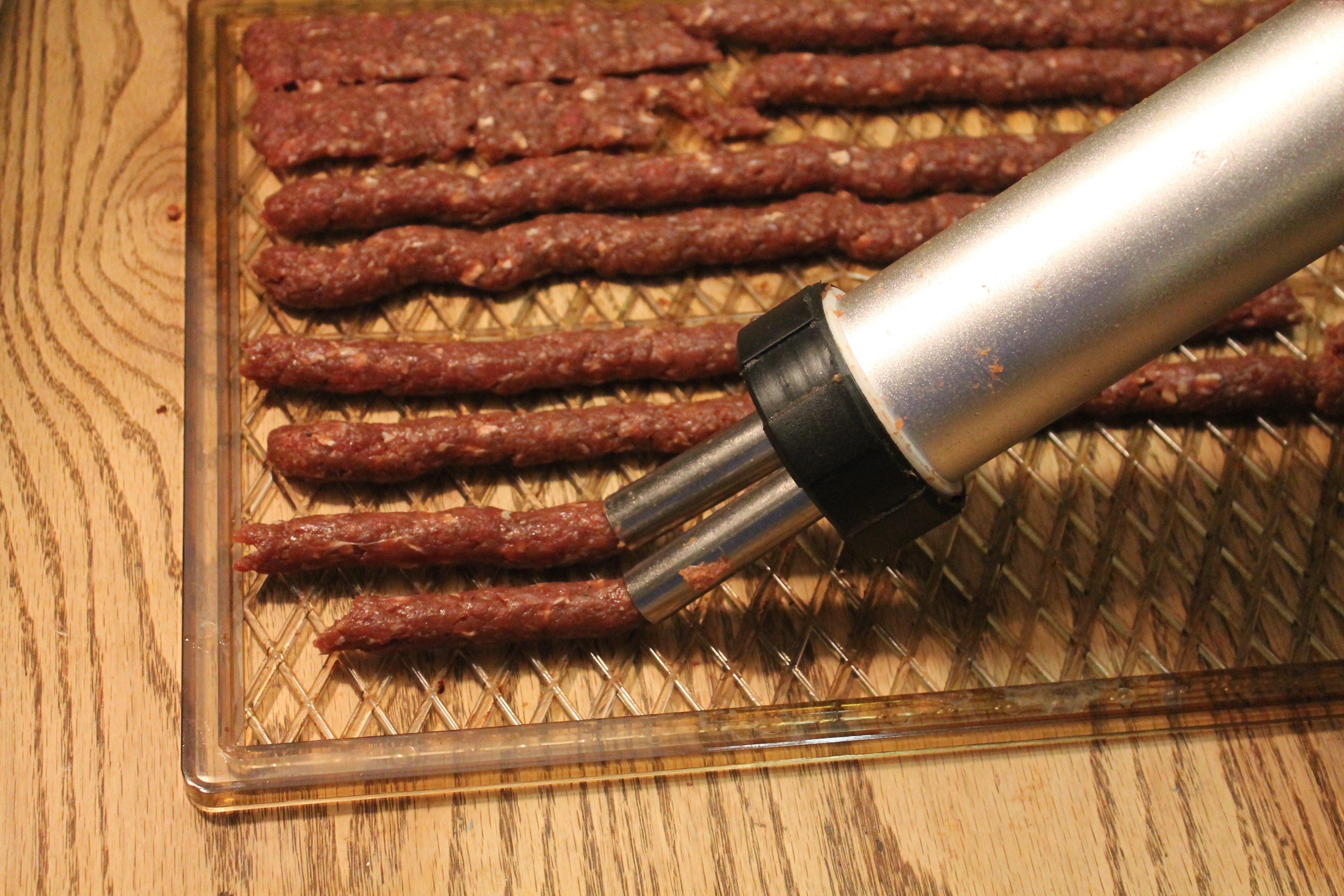Sliced Jerky vs. Ground: Which is Best?
Sliced Jerky vs. Ground: Which is Best?
Easy
Difficulty
Most hunters agree that jerky is just about the greatest snack food on earth. Only their jerky though; everyone else's jerky pretty much sucks. Deer camp arguments about the best jerky can go on for days; ground verses sliced, flat verses stick, shaved thin verses run through a jerky slicer, and everyone seems to have a different opinion on what makes the best finished product. Since my family of five goes through more jerky in a year than most small Midwestern towns, I thought I would experiment a bit and see what style my crack team of jerky-eating pros liked best.
To keep everything consistent, I used the same commercially produced jerky seasoning kit for each method and followed the package instructions. For those that like a more do-it-yourself style, I have included a few tried and true recipes below.
I started with the ground meat jerky. Using well-trimmed lean meat, I ran it through the Weston Realtree grinder twice, first through a coarse grinding plate, then another pass through the medium plate. Following package directions, I mixed in the correct amount of seasoning, cure and water and blended everything well. After the recommended 4-hour stint in the fridge, the meat mixture was loaded into the Weston Jerky gun.
Next up was sliced, whole muscle jerky. I chose different roast cuts from both the front and back quarters of a mature whitetail doe. On half of the meat, I ran the roasts over a meat slicer to make wide slices around an eighth of an inch thick.
Both of these went into a clean plastic meat lug and were coated with the same seasoning and cure mixture used for the ground jerky. Package instructions called for a 24-hour marinade for sliced jerky. After the marinade, the jerky slices went into the dehydrator at the same 150-degree temperature as the ground meat jerky. Nine hours into the drying process and both slices and strips felt about right.
The results? Did my team of jerky aficionados agree on the best style? Of course not, they all picked a different favorite. One thing they all did agree on was that they like the ground jerky in stick form rather than flat sticks. Potroast says they remind him of Slim Jims, his favorite gas station snack of all time. Michaela liked the thicker, less chewy slices, saying they reminded her more of a steak. Hunter liked the smaller strips from the jerky slicer, followed closely by the ground sticks. My wife, Cheryl, preferred the whole muscle style but liked the chewier pieces best.
So what did this little experiment tell me? There is no wrong way to do jerky, and not everyone is going to like the same style. Experiment with different styles and recipes. Find your favorite and make a bunch. You can never have enough.
Ingredients
The following recipes are all proven winners. They are designed for marinating sliced meat, but will work with ground as well. For ground jerky, try cutting the recipes in half and blending into five pounds of ground meat as a starting point. Adjust to your taste from there.
Tim's All Purpose Jerky and Duck Marinade Recipe
5 pounds of trimmed venison, sliced
¾ cup Soy Sauce
¾ cup Worcestershire Sauce
1 ½ Tablespoons Onion Powder
1 ½ Tablespoons Garlic Powder
Liberal shake of Red Pepper Flakes
1 level teaspoon Instacure #1 (pink salt)
Mix all ingredients. Marinate overnight to 24 hours and dry by your preferred method.
Donnie's Jerky Marinade
Five pounds trimmed venison, sliced
1 cup Worcestershire Sauce
¾ cup Soy Sauce
½ can of beer
½ cup bourbon
½ cup non diet soda of choice
¼ cup honey
2 Tablespoons Cajun Seasoning
1 level teaspoon Instacure #1 (pink salt)
Mix all ingredients and marinate overnight to 24 hours. Dry by preferred method.
Black Pepper Venison Jerky
5 pounds of trimmed venison, sliced
1 can of beer, amber or lager depending on which flavor you like
2 cups soy sauce
1/2 cup Worcestershire sauce
4 tablespoons cracked black pepper
1 level teaspoon of Instacure#1 (pink salt)
4 additional tablespoons black pepper
Mix venison with next five ingredients, marinate overnight to 24 hours. Lay venison strips out flat, and sprinkle with remaining black pepper. Dry by preferred method.
Maple Sage Venison Jerky
5 pounds of trimmed venison, sliced
1 cup of apple cider vinegar
1 cup of maple syrup
3 Tablespoons dried sage
3 Tablespoons sea salt
1/2 cup warm water
Ground black pepper to taste depending on how hot you like it
1 level teaspoon Instacure #1 (pink salt)
Mix all ingredients. Marinate overnight to 24 hours. Dry by your preferred method.
Cooking Instructions
Jerky Tricks and Tips
- Adding 1 level teaspoon of Instacure #1, also known as Prague Powder #1 or pink salt, per five pounds of meat is a great way to cure your jerky and guard against botulism. It also preserves the meat and increases safe shelf life.
- Slightly freezing your venison makes for much easier slicing.
- Slice meat with the grain.
- Trim all fat and silverskin from jerky meat. Fat doesn't store well and can become rancid and no one wants to try to chew a piece of dehydrated silverskin.
- Try to keep slices uniform, with a maximum thickness of ¼ inch for complete drying.
- Jerky can be dried any number of ways. Smokers, ovens and commercially produced dehydrators all work well. Try to keep the temperature at 170 degrees or below for drying without actually cooking the meat. If using a standard oven, set temperature at lowest available point and crack the door open with a wooden spoon handle or other device so that the air circulates and moisture escapes. The same is true for smokers, open top vents and keep temperatures low. Hickory, oak, mesquite and fruit woods like apple, peach or cherry all make fine tasting jerky in the smoker.
- Jerky drying racks greatly increase the amount of jerky that can be cured in a standard oven.
- Using a dehydrator with a rear mounted heating element and fan? Line the bottom with parchment paper to make clean up a breeze.
- If not using a smoker, smoke flavor can be added to any of these recipes by adding 1 Tablespoon of liquid smoke to the marinade.
- If you want to do ground meat jerky, but don't have a jerky gun, just roll seasoned meat mixture onto a piece of parchment or waxed paper, top with another piece of parchment and roll flat with a rolling pin. Peel paper from top of jerky and cut into strips with a pizza cutter. Transfer to dehydrator by flipping meat side down onto the drying racks, then remove remaining parchment paper.
- Don't want to wait 12 to 24 hours for your jerky to marinate? Seal the marinated meat with your vacuum sealer. The vacuum process forces the marinade into the meat, shortening the time by at least half.
- Jerky being jerky, it stores pretty well on its own. Want to keep it for longer than a couple of weeks? Put it in a quart jar with the lid screwed on tightly and stick it in the fridge for another couple of weeks. Need to store it longer than that? Vacuum seal it and stick it in the freezer. I can't tell you exactly how long it will last like this, as it always gets eaten pretty quickly around here, but I am guessing the shelf life to be just short of forever.












